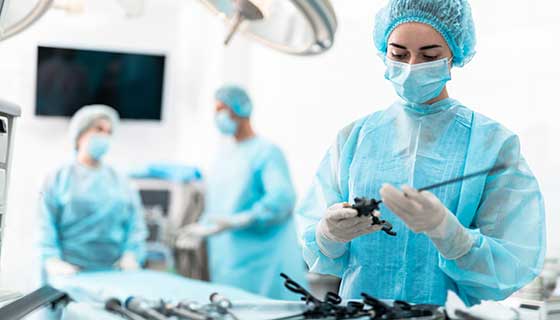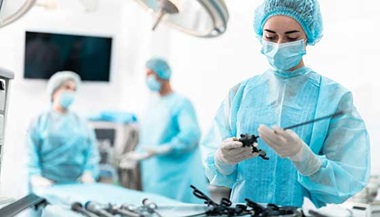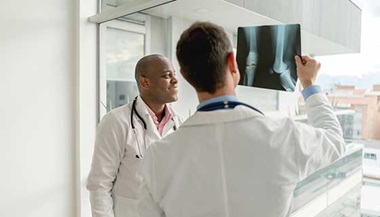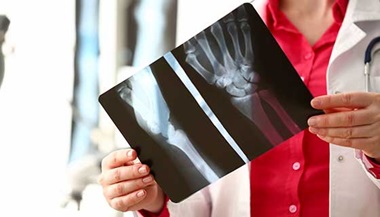Muscle Biopsy
What is a muscle biopsy?
A muscle biopsy is a procedure used to diagnose diseases involving muscle tissue. Your healthcare provider will remove a small portion of a specific muscle and view it under a microscope.
Your healthcare provider takes the tissue sample by inserting a biopsy needle into your muscle. If a larger sample is required, your healthcare provider may make an incision in your skin (open biopsy) and remove a larger section of muscle.
The muscle selected for your biopsy depends on the location of symptoms, which may include pain or weakness. The muscles often selected for sampling are the bicep (upper arm muscle), deltoid (shoulder muscle), or quadriceps (thigh muscle).
Why might I need a muscle biopsy?
You may need a muscle biopsy to assess your musculoskeletal system for abnormalities. Various diseases can cause muscle weakness or pain. These conditions may be related to problems with your nervous system, connective tissue, vascular system, or musculoskeletal system.
A muscle biopsy helps determine the source of the disease process. This ensures the proper treatment.
Your healthcare provider may do a muscle biopsy to diagnose neuromuscular disorders, infections that affect your muscle, and other abnormalities in your muscle tissue. These may include:
-
Muscular dystrophy (MD). A broad term that describes a genetic (inherited) disorder of the muscles. MD affects skeletal muscles and other organ systems. When the muscles break down, fatty deposits replace them over time. There are many different types of MD.
-
Duchenne muscular dystrophy (DMD). The most common form of MD. DMD usually affects only males.
-
Becker muscular dystrophy. Similar to DMD, this form is usually more mild, and symptoms start later in life.
-
-
Myasthenia gravis (MG). A complex, autoimmune disorder in which antibodies destroy neuromuscular connections. This causes problems with the nerves that communicate with muscles. MG affects the voluntary muscles of the body, especially your eyes, mouth, throat, and limbs.
-
Polymyositis. A chronic disease involving skeletal muscles.
-
Dermatomyositis. A collagen disorder that causes inflammation to the skin, muscles, and subcutaneous tissue, often resulting in weakened muscles.
-
Amyotrophic lateral sclerosis (ALS). Also known as Lou Gehrig disease. ALS is a disease that attacks the nerves signaling voluntary muscle movement, eventually causing paralysis.
-
Friedreich ataxia. An inherited, genetic disorder that involves balance and coordination.
-
Trichinosis. An infection caused by a parasite that lives in raw meat. Symptoms may include muscle pain. But a muscle biopsy is rarely done to diagnose trichinosis.
There may be other reasons for your healthcare provider to recommend a muscle biopsy.
What are the risks of a muscle biopsy?
As with any surgical procedure, complications can occur. They may include:
-
Bruising and discomfort at the biopsy site
-
Prolonged bleeding from the biopsy site
-
Infection of the biopsy site
Other risks may exist, depending on your specific health condition. Talk about any concerns with your healthcare provider before the procedure.
How do I get ready for a muscle biopsy?
-
Your healthcare provider will explain the procedure to you, and you can ask any questions you may have.
-
You will be asked to sign a consent form that gives your permission to do the procedure. Read the form carefully and ask questions before you sign if something is not clear.
-
In addition to a complete medical history, your healthcare provider may do a complete physical exam to ensure you are in otherwise good health before undergoing the procedure. You may have blood tests or other diagnostic tests.
-
Tell your healthcare provider if you are sensitive or allergic to any medicines, latex, tape, or anesthetic agents (local and general).
-
Tell your healthcare provider of all medicines (prescribed and over-the-counter) and herbal supplements that you take.
-
Tell your provider if you have a history of bleeding disorders, or if you take any anticoagulant (blood-thinning) medicines, aspirin, or other medicines that affect blood clotting. You may need to stop these medicines before the procedure.
-
If you are pregnant or think you could be, tell your healthcare provider.
-
You may be asked to fast for several hours before the procedure.
-
You may receive a sedative before the procedure to help you relax. Because the sedative may make you drowsy, you will need to arrange for someone to drive you home.
-
Based on your health condition, your healthcare provider may request other specific preparations.
What happens during a muscle biopsy?
Your healthcare provider may do a muscle biopsy on an outpatient basis, or as part of your stay in a hospital. Procedures may vary, depending on your condition and your healthcare provider’s practices. Generally, a muscle biopsy follows these steps:
-
You will be asked to remove clothing and will be given a gown to wear.
-
During the procedure, you will need to lie as still as possible.
-
A healthcare provider will clean the skin over the biopsy site with an antiseptic solution.
-
As your healthcare provider injects a local anesthetic to numb the area, you will feel a needle stick and a brief stinging sensation.
-
Your healthcare provider will insert the biopsy needle through your numbed skin and into the muscle to take the sample. You may feel some pressure, or pulling, during the procedure.
-
If a larger sample is required, your healthcare provider will make a small incision into the skin’s surface. Your provider may cut sections of your muscle tissue using small, sharp scissors instead of a biopsy needle. You may feel mild discomfort when the muscle is cut.
-
Your healthcare provider will withdraw the biopsy needle and apply firm pressure to the biopsy site for a few minutes, until the bleeding has stopped.
-
Your provider will close the opening in your skin with adhesive strips or stitches, if needed.
-
A healthcare provider will apply a sterile bandage or dressing.
-
Your provider will send your muscle tissue sample to the lab for exam.
What happens after a muscle biopsy?
Once you are home, it's important to keep the biopsy area clean and dry. Your healthcare provider will give you specific bathing instructions. If you have stitches, your healthcare provider will remove them during a follow-up office visit. Keep adhesive strips dry and they should fall off on their own within a few days.
The biopsy site may be tender or sore for 2 to 3 days after your muscle biopsy. Take a pain reliever for soreness, as your healthcare provider recommends. Aspirin or certain other pain medicines may increase your chance for bleeding. Be sure to take only recommended medicines.
Tell your healthcare provider if you have:
-
Fever
-
Redness, swelling, bleeding, or other drainage from the biopsy site
-
Increased pain around the biopsy site
You may resume your usual diet and activities, unless your healthcare provider advises you otherwise. Your healthcare provider may restrict your activity for 24 hours following the procedure and ask that you avoid excessive use of the biopsied muscle.
Your provider may give you other instructions after the procedure, depending on your particular situation.
Next steps
Before you agree to the test or the procedure, make sure you know:
-
The name of the test or procedure
-
The reason you are having the test or procedure
-
What results to expect and what they mean
-
The risks and benefits of the test or procedure
-
What the possible side effects or complications are
-
When and where you are to have the test or procedure
-
Who will do the test or procedure and what that person’s qualifications are
-
What would happen if you did not have the test or procedure
-
Any alternative tests or procedures to think about
-
When and how you will get the results
-
Who to call after the test or procedure if you have questions or problems
-
How much you will have to pay for the test or procedure





